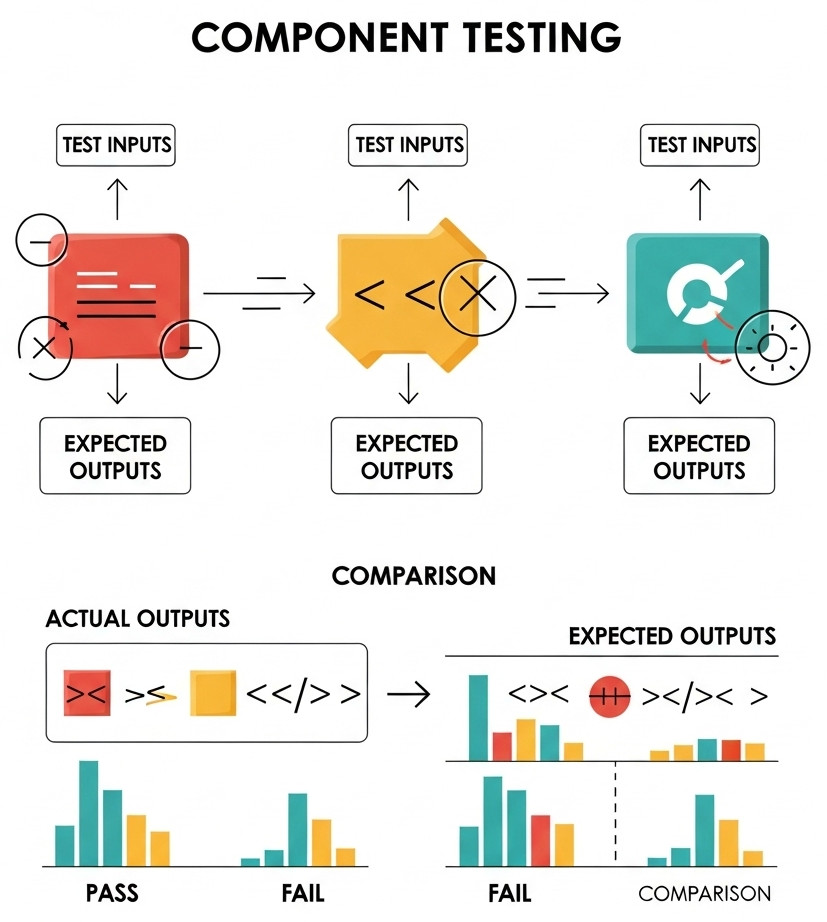Component Testing Automation – A Complete Guide
|
|
Today, we want the software to be fast, steady, scalable, and user-friendly. To uphold these lofty standards, teams develop using many different testing angles, including unit, integration, system, and the rest. Within these, component testing has a special role. It verifies the behavior of software units in isolation and serves as a continuum from unit tests to integration testing.
Component testing confirms that a part or a subpart of the application works properly on its own. The automation of this task provides not only a significant improvement in speed but also consistency and reliability.

| Key Takeaways: |
|---|
|
The following is an overview of automating component testing from fundamentals and planning to ways to implement it, and finally, to the doing.
What is Component Testing?
Component testing, also called module and program testing, targets checking out software units as separate components. It’s a white-box or gray-box set of tests, where the fellowship can see some, maybe much, of a component’s internals. Black-box vs Gray-box vs White-box Testing: A Holistic Look.
A “component” here can refer to anything that is a standalone code (for example, it may be a class, a module, a microservice, or a function that does a particular job). It doesn’t require your entire application to be loaded for testing; instead, it is tested in isolation, usually with dependencies mocked or stubbed.
Importance of Component Tests in the Software Lifecycle
Component testing is essential to the Software Development Life Cycle (SDLC). The main advantage is catching bugs early on or before the pieces are incorporated into the larger system. Developers can then quickly address problems, usually at a much reduced cost than for bugs found at system or acceptance testing.
By ensuring each piece of a system is functioning as designed, component testing reduces the possibility that defects will cascade to a final design or implementation in a way likely to be difficult to identify and correct. It also supports modular development, enabling separate teams to work on components in parallel without waiting for the entire system to integrate. This autonomy speeds up development times and provides better test coverage.
Moreover, since component tests are typically automated and fast, they’re ideal for frequent execution as part of continuous integration and delivery (CI/CD) pipelines. They become a critical feedback loop for agile and DevOps-driven teams aiming to release high-quality code rapidly. Read: Continuous Integration and Continuous Testing: How to Establish?
Objectives of Component Testing
Component testing aims at testing the internal logic and behavior of a software unit and ensuring it works in an acceptable manner when combined with several other components. This sort of testing is key to finding faults as soon as possible and building a solid and reliable system.
Key Objectives
- Verify Functional Behavior: This is to verify that each of the components will take inputs and generate proper output according to the designated logic.
- Validate Business Rules: Component tests should cover all business-specific rules or conditions that have been put into the module and how they should be followed.
- Ensure Error Handling: Simply test that the component handles unexpected or invalid inputs with grace and without crashing or creating incorrect output.
- Check Data Flow: This includes, but is not limited to, testing that the component produces, creates, changes, or returns internal data structures or values during its operation.
Scope of Component Testing
The scope for component testing is limited to the testing of a component which is supposed to test in isolation of any other software component. This is to say the test cases are developed to verify the behavior of the particular component with given (controlled) inputs and validate if the same yields the expected behavior considering the internal implementation logic of the same.
Component testing does not deal with integration points or interactions between components—those would be considered integration or system tests. The idea is to make sure that each part works in isolation before plugging it into a larger system. This type of testing invariably leads to the need to mock or stub out the component’s dependencies so that it can be tested in isolation.
For instance, let’s assume you have a login module with input validation, an authentication logic, and an error handling mechanism. You’d need to write three different sets of tests. One that would assert that the input validation correctly detects if nothing or the wrong value was entered. Second, it would assert that the authentication logic has a clause that can validate user credentials. Third, it simply does a system check to see if the error handling component and method show the right type and amount of errors. But to check the entire login sequence through to a completed process would be too much for testing components.
This type of testing helps identify defects early by narrowing the focus to individual components. It also makes debugging more straightforward since any failure is isolated within the tested unit.
When and Where to Use Component Tests
Component testing is most useful when performed as early as possible in a software development cycle, after a component is implemented (or modified). Testing at this level helps make sure that all known issues are resolved before the component is combined with other parts of the application. This early validation helps simplify and lower the cost of debugging downstream while enabling developers to be more responsive with the correctness of their code. Read: Testing vs Debugging.
The concept of component testing, however, is not confined to a particular class or category of software systems or architecture; rather, it is applicable in a broad range of domains and technologies.
Development of Core Application Logic
Code that enforces core business rules or crucial decision-making should be very highly tested. These are the parts of the application that usually make the application more complex and affect the application’s correctness and system stability. By unit testing, you’re verifying that the fundamental behavior is correct before it’s incorporated into anything else.
Reusable Modules
It is good practice to test shared libraries, helper functions, or shared services that are used in more than one place in the app as components. They affect every corner of your software, so even a tiny bug in these modules can explode. Component testing guarantees that these components are reliable and that they work properly, whether being used in an urban or rural area.
Microservices
Microservices are, by their very nature, designed to operate independently with clear boundaries. This makes them good candidates for testing components. Each microservice can be individually verified, not only with its internal logic, but also by verifying data transformation and how it reacts to inputs, before the service starts reaching other services, through APIs or message queues. Read more about MicroFrontend automation: Micro-frontends Automated Testing: Is It Possible?
Frontend UI Components
Modern frontend frameworks (React, Angular, etc.) are best built using components. Every UI component, including buttons, forms, and modals, can be worked with as a separate entity. Top-quality component testing means that these visuals appear and change as intended and remain consistent through various states and inputs.
Third-party Wrappers
In some common applications, users are expected to write wrapper code for third-party libraries or online services to adapt or simplify their use. Because these wrappers act as a bridge for your application to other systems, they should be tested in isolation. Component testing will guarantee that those wrappers interact and interpret the third-party data and errors correctly. So that, in the case of an external service change, you don’t have unexpected behavior.
Steps to Automate Component Testing
The stage of developing automated component testing is a way to guarantee that every software part is successfully tested in isolation, in a structured and reproducible way. This enables teams to catch bugs early, have high-quality code, and be able to test at scale across big codebases. The following is a summary of the major steps to achieve automated component testing:
Step 1: Define Component Boundaries
Be very clear about what a component is in your app – whether it’s a class, function, or service. This aids in keeping the testing focused on a well-scoped, self-contained unit of functionality.
Step 2: Identify Dependencies
Enumerate all external dependencies the component touches and schedule their isolation as a mock or a stub. This would guarantee that the component is tested separately from the other systems.
Step 3: Design the Test Scenarios
Illustrate particular scenarios with valid, edge and incorrect inputs. Each use case will be used to confirm a different part of the component’s functionality. Read: Test Scenarios vs. Test Cases: Know The Difference.
Step 4: Set Up the Test Environment
Generate a stable, isolated environment conducive to mocking, fast runs, and easy cleanup. This will ensure that the test results are comparable and consistent. Read: Managing Your Test Environment: What You Need to Know.
Step 5: Implement the Test Cases
Create test cases for your scenarios, specifying input, expected output and validation. Automate them to run repeatedly without human intervention.
Step 6: Integrate with CI/CD
Wire up your component tests to your CI/CD pipeline to automatically run with each code change. This results in fast feedback and reduces the risk of regressions.
Managing Test Data for Component Testing
Test data management is one of the essential elements for successful component testing. Realistic, heterogeneous, and precisely described input data help to provide complete coverage tests for the components under a wide variety of realistic conditions. Teams can find edge cases, prevent false positives, and increase the reliability of tests by thinking carefully about what data sources and data strategies they use. Read: Optimizing Software Testing with Effective Test Data Management Tools.
Data Sources
Use test data sources to establish the proper context for meaningful, repeatable component tests. Picking the correct data source contributes to robust validation of component behavior under different environments.
- Static Data: These are inputs that are hard-coded into a particular test, in which predictable, reproducible inputs are all that is necessary to assert the basic behavior of a component.
- Data Factories: Programmatic tools or scripts provide generated testing data based on real-world scenarios in order to have different data inputs and outputs.
- Mock Databases: In-memory or other temporary databases emulate a real database interaction, allowing isolated unit tests to be performed without the need for the real backend.
- CSV/JSON/YAML Files: Structured files can externalize test inputs to improve test management, modification, and reusing without changing the test logic itself.
Data Strategies
Effective data strategies also become more efficient than component testing if the test space gets large. These methods help to surface defects that would not approach the surface on small or repeated data. These strategies offer.
- Parameterized Tests: This method applies identical test logic to several data subsets, thus improving the coverage and avoiding redundancy in your test code.
- Edge Case Coverage: This consists in verifying that the component works properly with edge cases (very large or small inputs, empty fields, wrong formats) and the system behaves as expected in those cases.
- Randomized Inputs: By producing random (or diversified) data, this approach helps uncover non-deterministic issues or makes the component more resilient to surprising input patterns.
Proper test data management improves the robustness of component tests and ensures comprehensive validation of the component’s logic.
Isolation of Components Using Mocks and Stubs
A key aspect of component testing lies in the standalone testing of components. This usually involves substituting actual dependencies with mock implementations or stubbed versions of those dependencies.
Mocks
Mocks are objects that behave like real dependencies. They give complete control for stubbing the input and output of these dependencies, by which the test will be consistent and predictable. Mocks can also be used to assert interactions, like checking that a method was called and how often or what it was called with.
Stubs
With Stubs, you can specify the return value for the method call or data query. They are not as dynamic as mocks and do not log usage, but they are easier to write.
Mocks and stubs make sure that failure at the component level is just isolated to that particular component and not the other systems. That achieves more accurate, faster tests. Read more: Mocks, Spies, and Stubs: How to Use?
Data-Driven Component Testing
In data-driven component testing, the same test logic is executed on a variety of input data sets. This technique will increase your test coverage, expose hidden problems, and verify complex logic more efficiently.
- Improves Test Readability: Separation of test logic from data makes tests easier to understand, maintain and assess, especially when a big variety or amount of tests are present.
- Simplifies the Addition of New Scenarios: Test logic doesn’t need to be changed to add new input combinations, so it’s fast to add new coverage as requirements grow.
- Encourages the Reuse of Test Logic: The identical test structure may substantiate multiple scenarios, promoting uniformity and minimizing maintenance.
- Reduces Duplication in Test Code: Data-driven testing removes the need for duplicative test case logic, making the codebase less prone to complexity.
Data-driven testing is especially useful when testing components that involve multiple conditional paths or user-generated input.
Role of Component Testing in Microservices
Microservices are just a natural fit with component testing. Every microservice is an autonomous component with its own well-defined public interface and its own narrowly-contained business responsibility. Automated component tests of these services individually allow for:
- Verification of Contract Compliance: Component testing makes sure that each module conforms to the input and output contracts agreed upon, it prevents side effects at the later stages of integration.
- Testing of Internal Logic Before API Exposure: It tests the internal consistency of a component independently from input/output side effects that would make use of or deliver data to an external system or user from an API.
- Early Detection of Breaking Changes: By running automated tests on every change, component testing enables teams to find and fix bugs before they spread throughout the system.
- Simplified Debugging During Development: It’s far easier to find and squash bugs by testing components effectively, which limits the scope of breakage to a single unit.
As microservices operate via APIs, their component tests are usually based on sending some requests to ensure the API performs as expected. To ensure independence and velocity, these tests must mock all service-to-service communication.
Conclusion
Component automated testing is an essential part of any successful or scalable software system. It aids in early defect detection, accelerates development cycles, and improves overall code quality. With good planning, data control, and integration to CI/CD pipelines, teams can take real advantage. For enterprise applications, microservices, or UIs, component testing builds a very strong basis for scaling development.
| Achieve More Than 90% Test Automation | |
| Step by Step Walkthroughs and Help | |
| 14 Day Free Trial, Cancel Anytime |












